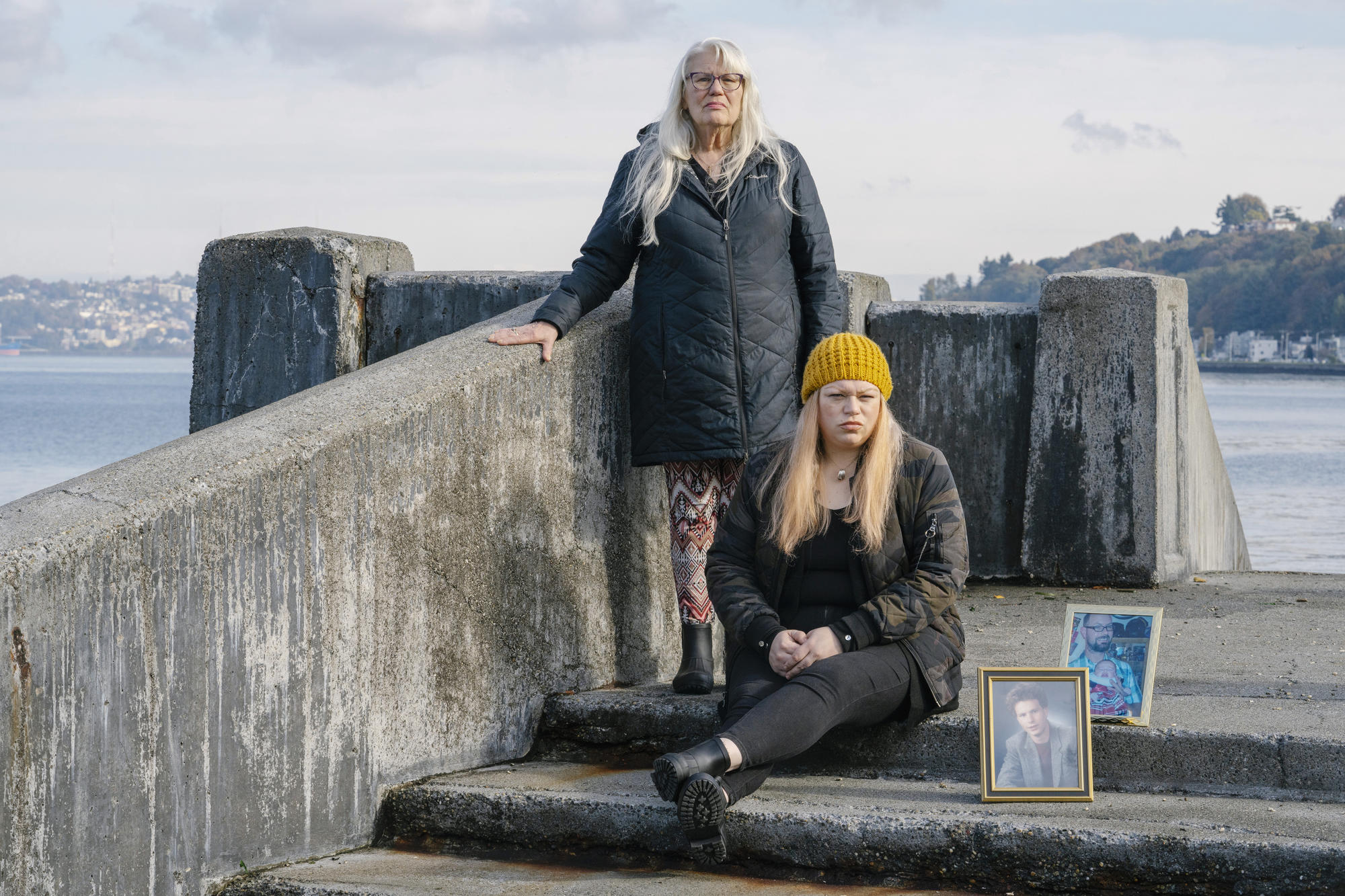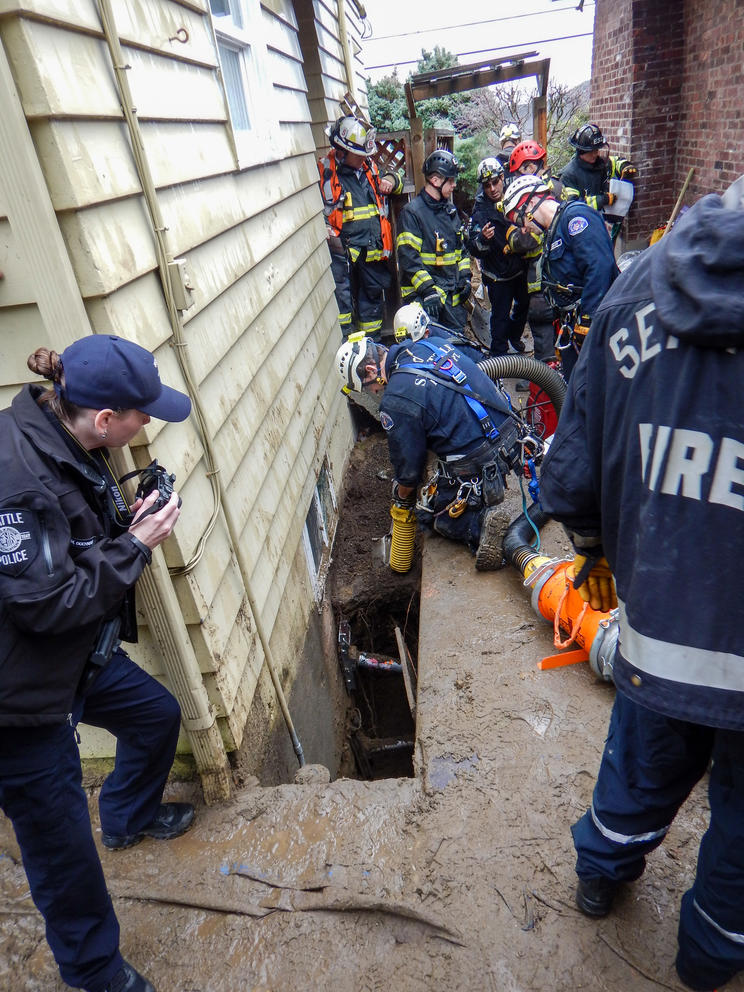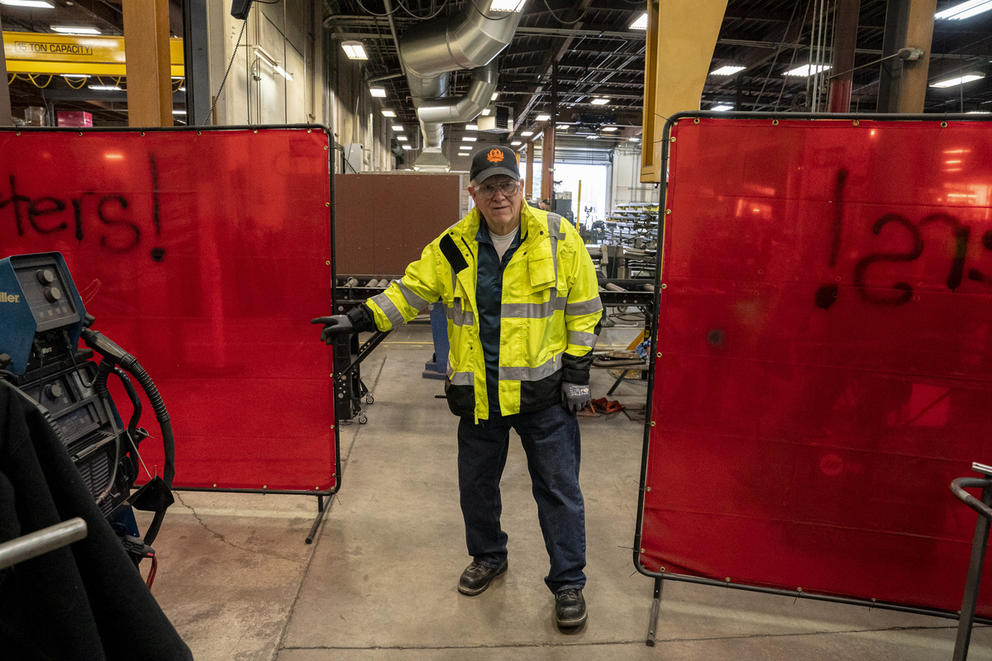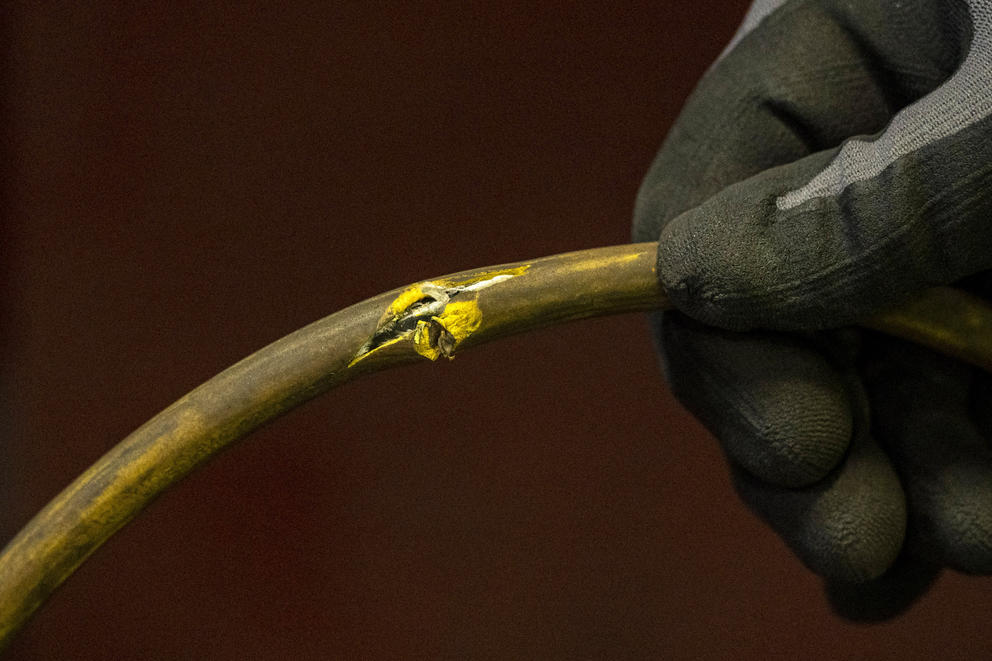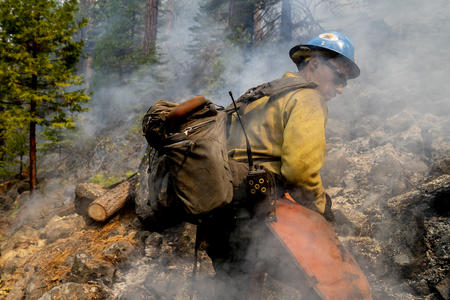“After calling his name for about five seconds, I looked back down in the hole and saw the whole front of it had caved in. I couldn’t believe it,” he told investigators. “I just freaked out and jumped in.”
He frantically dug at the pile. With each shovel load, still more dirt spilled back into the ditch. It would take three and half hours for firefighters to free Felton’s body. He was 36 years old.
Investigators later confirmed that the trench where Felton died in January 2016 lacked the legally mandated safety shoring – a support system to prevent the movement of soil – that would have likely saved his life. The construction company Felton worked for had never had one of its sites inspected by the state.
Washington saw 80 trauma-related workplace deaths last year, the highest number since 2010, according to state figures. The state’s Department of Labor & Industries bears responsibility for enforcing safety standards and investigating workplace fatalities. The agency imposed more than $14.7 million in fines last year for employer safety failures, injuries and other violations.
This story is part of Crosscut’s WA Workplace Watch, an investigative project covering worker safety and labor in Washington state.
Following Felton’s death, King County prosecutors took the rare step of charging Phil Numrich, the owner of Alki Construction where Felton worked, with felony manslaughter. The case set a new precedent for holding employers accountable for worker fatalities while also revealing the limits of the state’s authority and ability to curb dangerous practices.
Nearly eight years later, Numrich remains in business despite additional L&I citations in the time since, including repeat violations of trench safety requirements. The agency rarely imposes a punishment that puts an employer with repeated serious offenses, or those deemed a severe violator, out of business. Felton’s family and worker advocates argue officials must do more to proactively head off such avoidable tragedies. Officials acknowledge that could involve a broader pursuit of criminal punishment.
“Trench collapses are definitely preventable. They are some of the most well-known hazards,” said Jordan Barab, a former deputy assistant secretary for the Occupational Safety and Health Administration, the federal agency that oversees worker safety. “It’s always shocking to me how many employers don’t comply.”
The same is true of most other kinds of workplace deaths.
“Almost every one of them,” Barab said, “is some kind of violation of a [safety] standard.”
Investigating the aftermath
More than three dozen emergency workers answered the 911 call after Felton’s fatal entrapment on Jan. 26, 2016. They tracked a muddy trail of footprints across the small residential lot. As the operation shifted from rescue to recovery, a vacuum truck arrived to speed excavation.
The Seattle Police Department would later declare Felton’s death “accidental” and turn over the investigation to L&I.
“The Medical Examiner’s initial examinations corroborated the witness’ accounts and no criminal wrongdoing was suspected,” the police report stated.
Photographs and investigation documents show L&I investigators found that shoring boards had lined just two sides of the trench – not all, as mandated by safety standards. A ladder, required to provide an exit out of the trench, lay off to the side of the hole instead of within. The surrounding earth consisted of Type C soil – the most unstable variety.
Washington is one of 22 states that runs its own workplace safety and compliance agency, which is overseen and partially funded by the federal OSHA. L&I’s 143 compliance officers, who bear responsibility for protecting the safety of nearly all workers except federal employees, conducted about 4,600 workplace inspections last year.
J.C. Smith, a safety and health consultant with the Washington State Department of Labor and Industries, walks through a MacDonald-Miller shop during a safety consultation in Seattle on April 4, 2023. The company participated in an L&I safety check earlier this year to proactively identify potential hazards and was not involved with the fatal trench collapse in 2016. (David Ryder for Crosscut)
Craig Blackwood, who leads L&I’s division of occupational safety and health, said the agency strives to educate employers on safety risks through its robust consultation program, but also takes complaints from individual workers seriously to help identify and prioritize inspections.
“If we have employees complaining, typically those are good places for us to spend our inspectors’ time,” Blackwood said. “We actually send inspectors on most complaints. It takes some initiative for employees to file complaints, and so we take that into account.”
An L&I officer will never step into the vast majority of workplaces in Washington. An AFL-CIO 2023 Death on the Job report calculated the agency would need nearly 60 years to inspect each workplace under its jurisdiction just once. Nationally, states averaged almost three times that length at about 167 years to complete such inspections.
Much of L&I’s safety and health enforcement remains complaint-driven. About two-thirds of on-site inspections occur after a serious incident or after someone has reported a potential safety hazard.
The other one-third of inspections target industries or companies with high rates of injuries and illnesses, or are a scheduled follow-up for a previous citation. Blackwood described those inspections as important, but a lower priority than responding to incidents or complaints.
Find tools and resources in Crosscut’s Check Your Work guide to search workplace safety records and complaints for businesses in your community.
Records show no on-site inspections for Alki Construction prior to the 2016 trench collapse that killed Felton. He died just a few miles from his childhood home, where his family still lives. His mother, Pam Felton, recalled how her only son had loved reading and riding his bike through the neighborhood. His favorite route took him along the water bustling with harbor traffic.
As a young man, Felton never said no to helping someone out. He doted on his infant daughter.
“Nobody should outlive your child, ever,” Pam Felton said, wiping away tears. “You just get up every day. Try your best. You get caught up in everyday life. You forget about it, but … I’ll never be the same.”
Nothing, she said, could make up for that loss.
Following its investigation, L&I officials cited Numrich in July 2016 with eight violations, alleging he knowingly disregarded safety standards that put Felton’s safety at risk. They also issued $51,500 in fines.
Appealing penalties
Several months after the deadly trench collapse, Numrich sat next to his lawyer in an L&I conference room in Tacoma to ask the agency to cut his fines in half. Throughout the 45-minute appeals hearing, Numrich blamed the cave-in on broken equipment and the long stretch of time the trench spent open exposed to the rain, but also acknowledged he had failed to provide the requisite safety equipment to prevent a cave-in.
“Yes, there were no end boards,” Numrich said. “I really, really, really wish that there was.”
Numrich did not respond to multiple phone calls and text messages seeking comment for this story. He told investigators he considered Felton a friend, not just an employee, according to an audio recording of the hearing. They met as teenagers, running in the same circle in West Seattle.
“I was the best man at this guy’s wedding,” Numrich said.
L&I bases penalty amounts on the seriousness of the citation, then adjusts for the size of the business and its safety history. Companies or employers can appeal through what’s known as an informal conference. Numrich argued more than $50,000 in fines would bankrupt him.
“I’m not trying to lay my life on you. I’m telling you, damn … ”, Numrich said, drawing out the word and accenting it with nervous laughter, “I can’t afford that.”
Employers with a clean safety record who agree not to appeal their citations further can be given a 25% reduction, according to Matt Ross, a spokesperson for L&I. A Crosscut analysis of L&I penalties found the agency reduced about 35% of fines between 2017 and 2021.
L&I granted Numrich’s request, cutting his fines to $25,000 – but also required him to inform L&I of future sewer repair projects.
Washington state law stipulates that most documentation for the investigations of fatal or serious workplace injuries, including notes and hearing recordings, remain confidential, requiring a court order to be released.
Two years later Numrich was back in front of an L&I officer, again appealing citations for violating many of the same safety rules at a different job site in 2018. That investigator also noted that the access ladder not only again lay outside the trench, but also was broken and damaged. This time L&I reduced the $13,200 in fines for the 2018 violations by 96% after Numrich appealed these too.
Ross attributed the 2018 reduction to the removal of a “willful” designation. “The trenches on the site were fully shored against collapse, so they were different violations than we saw in the fatality,” he said.
Samantha Grad, political director for Teamsters 117 and a member of L&I’s safety and health advisory committee, argued companies have little incentive to ensure a safe work environment when penalties continue to get reduced even after a pattern of repeated violations.
Unions and workers are involved when complaints are filed and during the L&I investigation, but Grad said they are usually left out of the citation and appeal process.
“It would be nice to be a part of the process,” Grad said, “to ensure that we’re actually holding employers accountable for creating unsafe work environments for their employees.”
It’s a bit of a sore spot that everyone else gets to weigh in, said Monty Anderson, executive Secretary of Seattle Building and Construction Trades Council, but it’s the employee who goes back to the job site.
“I wish we had a little more say on the enforcement side,” he added.
J.C. Smith, a safety and health consultant with the Washington State Department of Labor and Industries, inspects a damaged power cable during a consultation at a MacDonald-Miller shop in Seattle on April 4, 2023. These types of safety consults give companies a chance to receive feedback to ensure they are up to code before receiving any fines from the state. (David Ryder for Crosscut)
‘A terrible law’
Safety is nearly always top of mind for Jay Herzmark. The retired in-house safety officer, who has worked at the University of Washington and a now-shuttered paper mill in Everett, dons bright colors and a helmet over his salt-and-pepper hair as he travels by bike around the city.
Herzmark said he routinely spots worksite hazards and risky practices, including unprotected trenches, at active construction sites when he passes by.
“I have this thing about people getting killed in trenches,” he said. “It’s completely preventable. If the company that digs trenches follows the rules, no one gets killed.”
Trenches need to be dug for all kinds of work – laying electrical lines or telephone wire, installing plumbing or drainage pipes – replacing and growing infrastructure lines. In Washington, any time a trench runs deeper than four feet, the sides either need to be sloped or a protected shoring system must be installed. Five feet is the national OSHA standard.
Keith Johnson, the director of strategic marketing for National Trench Safety, a nationwide rental and training agency, said most fatal trench collapses lack the proper shoring to protect a worker. Since 2016, at least five workers in Washington have died in cave-ins – three of them just last year.
“We see companies all the time that are just entering the market and they don’t realize how dangerous it is,” Johnson said. “There are some that do realize how dangerous it is, and they just cut corners. And it’s the worst kind of corner you can cut.”
With 39 fatalities nationwide, 2022 marked one of the deadliest years for trench collapses, more than double the previous year. Johnson said he expects the number of crews working in trenches to increase with the influx of federal dollars for upgrading aging infrastructure.
Herzmark first came across Felton’s death in a press release L&I sent out announcing the $51,500 fine in 2016. He said he considered the initial fine inadequate, and predicted, based on his experience, that it would likely be reduced substantially.
“They almost treat it as an act of God,” Herzmark said, “instead of these intentional acts done by people.”
He wanted to see a tougher penalty for Numrich, knowing L&I could seek criminal charges under a little-used state law.
“Every industrial hygienist knows that rule,” Herzmark said. “The reason why we know it is because the maximum sentence is only six months in jail. … It’s such a terrible law, but we talk about it all the time.”
The same year Felton died, King County prosecutors charged Pacific Topsoil under the law when a worker died on the job. After a guilty plea, the company was given a $100,000 fine by the court.
Herzmark eventually launched a campaign to convince the King County prosecutor’s office to investigate the death. He started with a letter signed by more than 100 people, including the former head of L&I, safety experts, labor leaders and union members.
Herzmark also pressed prosecutors to go beyond the misdemeanor statute and file manslaughter charges against Numrich for his alleged role in the death – a step that had never been taken in the state. Officials moved ahead with charges in January 2018.
L&I’s Blackwood said the agency had also taken steps to prepare a criminal case.
“It just wasn’t necessarily seen in the public eye,” he explained.
M. Isabelle Chaudry, a senior policy analyst for the Center for Progressive Reform, said it’s still unusual to see criminal charges over a workplace fatality, but it’s becoming more common.
In its Crimes Against Workers Database, the center tracks criminal prosecutions stemming from worker deaths or injuries. Chaudry said taking penalties a step beyond monetary fines might hold employers more accountable and could result in better policy around worker safety.
“Stronger penalties,” Chaudry said, “often lead to stronger safety standards.”
Criminal consequences
As they filed into a King County courtroom in March 2022, Felton’s mother and sister shook off the early spring chill. His widow sat nearby. They had all waited a long six years for this day. With Numrich now seated at the defendant’s table, the family had come in search of whatever justice or accountability might be offered.
While the felony manslaughter charges against Numrich had set a significant precedent for workplace safety, legal challenges had pushed the case up to the Washington Supreme Court. Numrich’s lawyers argued state law precluded the prosecution from filing manslaughter charges since a special statute existed that addressed worker deaths.
The Supreme Court justices disagreed.
After that decision, prosecutors ended up dropping the manslaughter charge when Felton’s co-worker took more responsibility for safety at the worksite than he originally acknowledged. Court records show Numrich pleaded guilty to the remaining charge of attempted reckless endangerment, a misdemeanor with a maximum penalty of 90 days in jail. He now faced sentencing.
King County Deputy Prosecutor Patrick Hinds asked the judge to sentence Numrich to 30 days in jail with another 60 days suspended. According to an audio recording of the hearing, Hinds urged the judge to send a message to employers.
“This … in many ways is a first-of-its-kind prosecution of the state of Washington,” Hinds told the judge. “The court has the chance to clearly communicate that this sort of behavior is a crime, and that it is worthy of imposing jail.”
One by one, Felton’s survivors stepped forward to share their grief and frustration with the court.
“Ladies and gentlemen, as mothers, fathers, wives and relatives, how would you feel knowing that a careless individual who took away the love of your life gets to walk away with such a minimal penalty?” asked Felton’s widow, Jenna Felton, her voice growing louder and louder. “We don’t agree with this arrangement. And we want Philip Numrich to receive the maximum penalty permitted by law.”
Felton’s mother addressed the court last on behalf of the prosecution.
“The void is immense, and we are forever changed. … I am a shell of a person now. Harold’s death has devastated me. I am heartbroken, sad and angry,” Pam Felton said to the judge. “I am not whole and I will never be. Justice must be served for Harold, and for current and future workers. No one should die on the job.”
Numrich’s defense team requested a sentence of 240 hours of community service. Numrich also agreed to 18 months of probation, during which he could not oversee construction jobs that involved digging trenches deeper than four feet.
Stepping before the court and Felton’s family, Numrich alternated between expressing sympathy for the family and defending himself. He emphasized that he cared deeply about the safety of his crews and often reminded them to stay safe, and that he was not a negligent person.
“I’m sorry to the Felton family for their loss every day,” he said. “I think about his family. And the things that could have been done differently on that day.”
In the end, the judge handed down a sentence of 45 days in jail.
“I can’t run away from the fact that a lot of life was lost here because of recklessness that’s been acknowledged,” Judge J. Michael Diaz said at sentencing. “And a life that was lost in a really gruesome way.”
Deadly collapses continue
Blackwood, the head of L&I’s safety division, considered the jail sentence a big deal.
“It wasn’t a lengthy amount of jail time, [but] it was more time than anybody has ever received previously,” said Blackwood, who has been at the agency since 1991. “My desire is to actually do more criminal prosecutions.”
No other criminal sentences have since been imposed on employers. In 2020, L&I referred a case in which a worker died in a trench collapse on a wind farm to prosecutors in Lewis County. The judge later dismissed the cases citing lack of evidence, according to The Chronicle.
Workers have continued to die in trenches across the state. In July 2022, two people, a contractor and their employee, suffocated at the bottom of a 24-foot trench that had also collapsed the day before. No shoring stabilized the ditch’s steep, nearly vertical sides. L&I issued no citations for those deaths.
A few months later, a trench collapse in Renton claimed another life. L&I later handed out eight citations, three of them with willful fines and penalties of $145,000. The contractor is currently contesting them.
Blackwood said it was too early for him to comment if L&I was seeking criminal charges in the recent fatal trench collapses.
The agency did launch an emphasis program this year to stress proper trenching compliance, in which officers were instructed to examine any open trench they see that is four or more feet deep. In the first 10 months of the program, investigators stopped 150 times, issuing violations more than 60% of the time, according to data provided by L&I.
“Our goal is always zero. That’s really all it can be,” Blackwood said. “I am not sure if every single one is preventable, [but] there’s far too many that are preventable, and that are easily preventable.”
‘Chances, chances, chances’
Felton’s family said they thought they had lost him once before: Years ago, a Ford F-150 truck slammed into an 18-year-old Felton as he biked through the familiar streets of West Seattle.
“When we arrived at the hospital, they gave us a private room and a priest,” his sister Lucy Felton recalled nearly two decades later.
It was Numrich who waited with Felton until an ambulance came, the family said. Felton survived, but spent years recovering from a traumatic brain injury.
Despite their long relationship, Felton’s mom and sister said they immediately had misgivings when Felton went to work for Numrich’s Alki Construction crew in search of a larger paycheck. Half a year later, and four months to the day after his daughter was born, Felton died under the weight of heavy, wet soil.
Felton’s family said L&I failed Harold repeatedly – by not heading off trench safety violations more aggressively, dragging their feet on criminal charges and allowing Numrich to operate even as he re-violated.
“They didn’t do their job prior to him dying,” Lucy Felton said. “They didn’t do their job with his case. And they didn’t do their job after.”
Earlier this month, a call to Numrich’s phone triggered an automatic text response familiar to many homeowners contacting contractors looking for bids.
“We are currently in a meeting right now,” the message stated. “Please text back and a technician will get back to you shortly.”
As Numrich faced criminal charges, he remained in business with a handful of employees, according to L&I. Records show Numrich had pledged to close the business after he paid his fines in full. While he paid off his fines in 2018, Secretary of State records show Numrich dissolved Alki Construction in 2022 – two years after he had registered another sewer company that he continues to operate.
“It’s a perfect example of everything to go wrong,” Lucy Felton said. “Chances, chances, chances.”
A Blackwood quote has been updated for accuracy.

